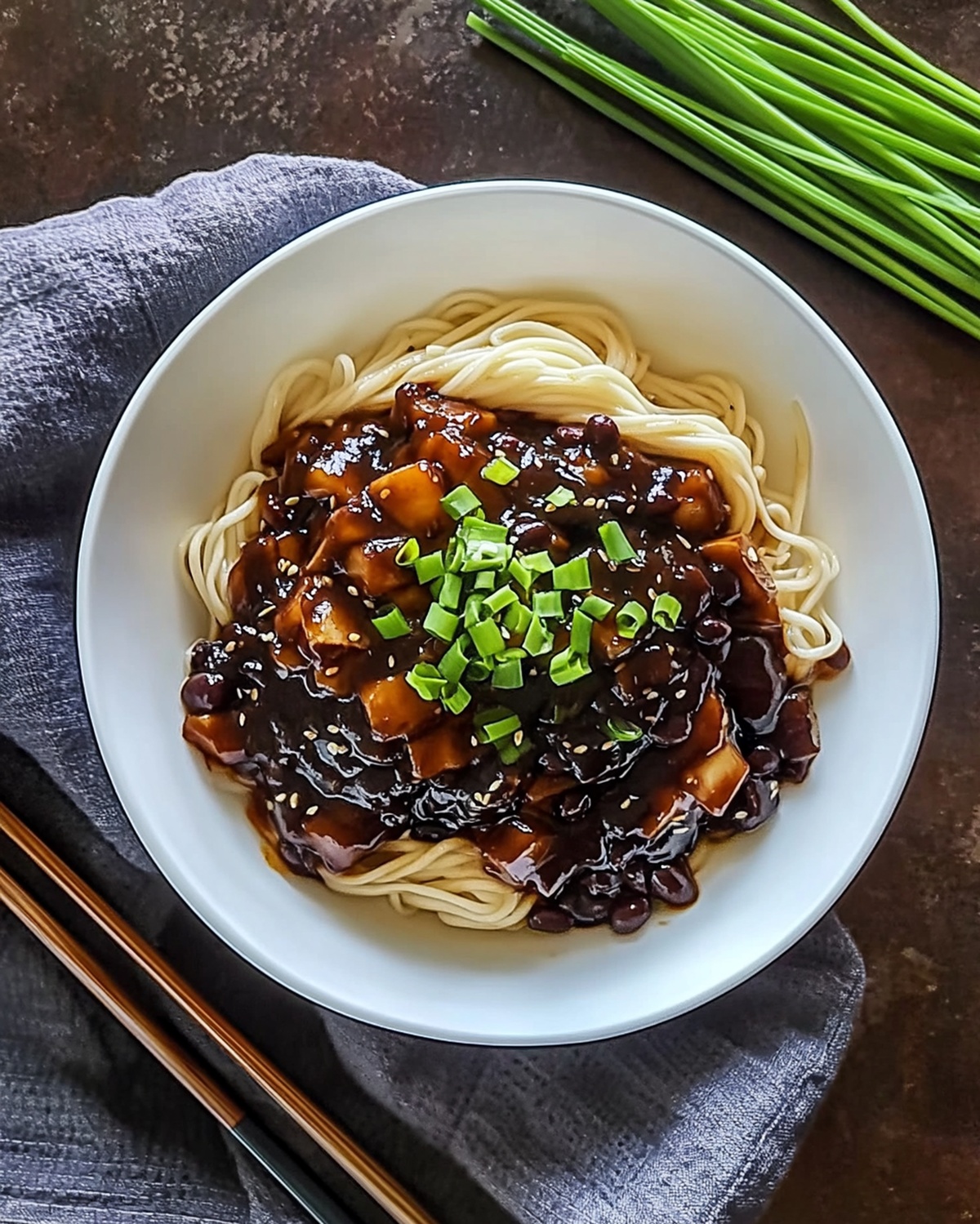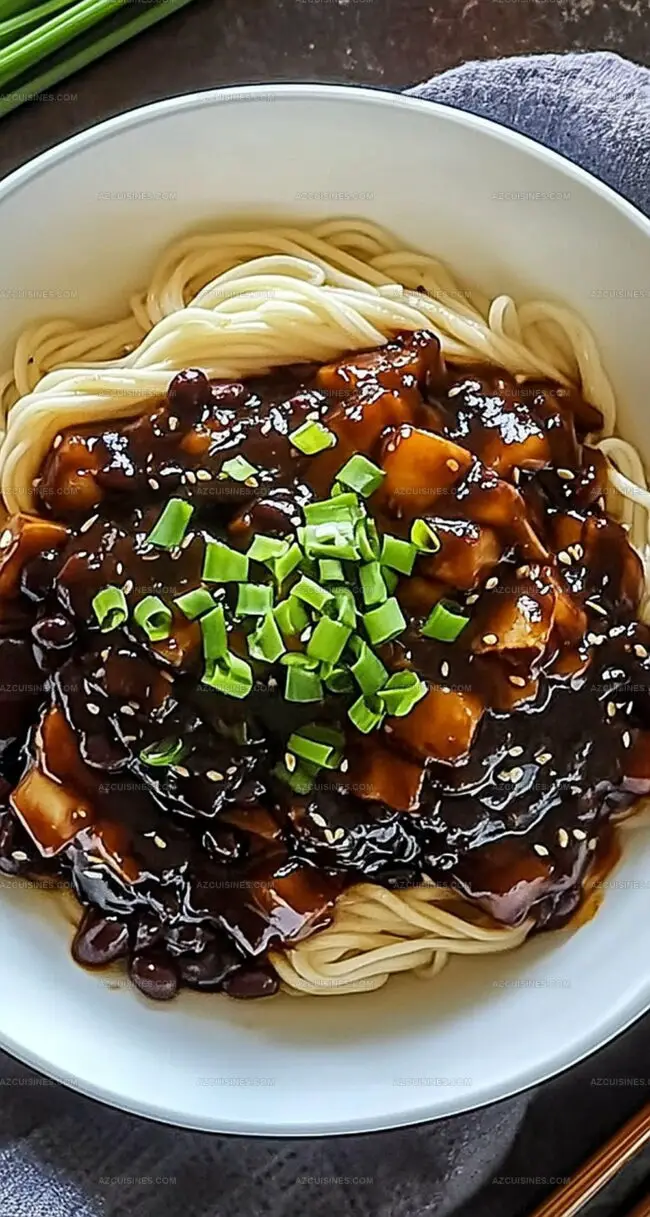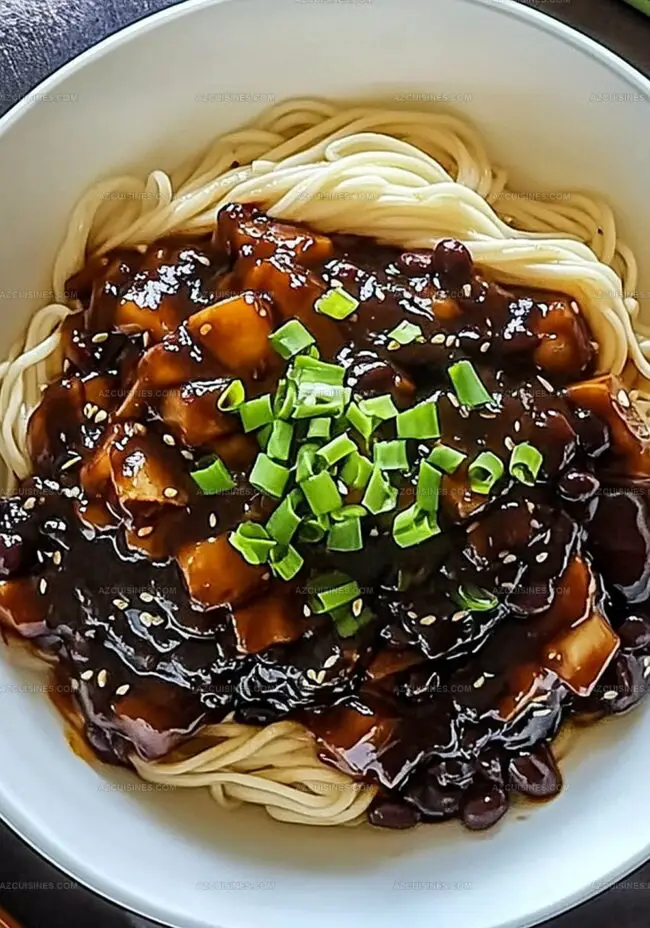Savory Jajangmyeon Vegetarian Korean Black Bean Noodles Recipe
Craving a delightful vegetarian jajangmyeon that bursts with authentic korean flavors?
Savory black bean sauce coats thick noodles in this plant-based twist on a classic street food favorite.
Mushrooms and zucchini add meaty texture without compromising the dish’s rich umami profile.
Home cooks can easily recreate this comfort meal with simple ingredients found in most pantries.
Chopping vegetables becomes a meditative process that connects you to korean culinary traditions.
Fragrant aromatics like garlic and ginger infuse the sauce with depth and warmth.
You’ll fall in love with this easy, satisfying noodle dish that proves vegetarian cooking can be both exciting and deeply delicious.
Why Jajangmyeon Vegetarian Korean Black Bean Noodles Are Comforting
What Goes Into Jajangmyeon Vegetarian Korean Black Bean Noodles
Main Ingredients:Vegetables:Seasoning and Thickening Agents:Cooking Instructions For Vegetarian Jajangmyeon
Step 1: Cook Noodle Base
Boil udon or wheat noodles following package directions. Drain completely and set the noodles aside while preparing the sauce and vegetables.
Step 2: Sauté Vegetable Medley
Heat vegetable oil in a large skillet over medium heat. Add the following vegetables:Cook the vegetables for 5-7 minutes until they become tender and slightly golden.
Step 3: Enhance Aromatic Flavors
Sprinkle minced garlic into the vegetable mixture. Stir continuously for one minute to release the rich, fragrant notes.
Step 4: Create Signature Black Bean Sauce
Introduce black bean paste and sugar into the skillet. Stir and cook for two minutes, ensuring the vegetables are completely coated with the dark, flavorful sauce.
Step 5: Build Sauce Consistency
Pour vegetable broth or water into the skillet. Bring the mixture to a gentle simmer.
Reduce heat and let it cook for an additional 5 minutes.
Step 6: Thicken Sauce Texture
Blend cornstarch with water to create a smooth slurry.
Pour into the skillet and stir thoroughly to achieve a rich, glossy sauce consistency.
Step 7: Combine Noodles and Sauce
Add the previously cooked noodles to the skillet.
Toss gently to ensure every strand is beautifully coated with the vegetable black bean sauce.
Step 8: Plate and Garnish
Transfer the steaming jajangmyeon to serving plates.
Top with julienned cucumber for a crisp, refreshing finish that complements the deep, savory flavors.
Tips To Make Jajangmyeon Even Better
Twists You Can Try On Jajangmyeon Vegetarian Korean Black Bean Noodles
Perfect Pairings For Jajangmyeon Vegetarian Korean Black Bean Noodles
Store Jajangmyeon Vegetarian Korean Black Bean Noodles With Ease
FAQs About Jajangmyeon Vegetarian Korean Black Bean Noodles
Black bean paste (chunjang) is a savory, salty Korean sauce made from fermented black soybeans. You can find it in Asian grocery stores, specialty markets, or online Asian food retailers.
No, the traditional recipe uses wheat noodles. To make it gluten-free, substitute udon or wheat noodles with rice noodles or gluten-free noodle alternatives.
Yes, add gochugaru (Korean red pepper flakes) or sriracha sauce to increase the heat level according to your preference. Start with a small amount and adjust to taste.
Print
Jajangmyeon Vegetarian Korean Black Bean Noodles Recipe
- Total Time: 25-30 minutes
- Yield: 2 1x
Description
Hearty jajangmyeon invites vegetarian comfort through rich Korean black bean sauce dancing over tender noodles. Savory mushrooms and crisp vegetables create a plant-based twist on this classic street food delight you’ll crave again and again.
Ingredients
Noodles and Vegetables:
- 8 ounces (226 grams) udon noodles or thick wheat noodles
- 1/2 medium onion, diced
- 1 small zucchini, diced
- 1 small potato, diced
- 1/2 small cabbage, shredded
- 1/2 cup mushrooms, sliced
- 1/2 cucumber, julienned for garnish
Sauce and Seasonings:
- 1/4 cup black bean paste (chunjang)
- 1 tablespoon sugar
- 1 tablespoon minced garlic
- 1/2 cup vegetable broth or water
- 1 teaspoon cornstarch
Cooking Liquids and Oil:
- 2 tablespoons vegetable oil
- 1 tablespoon water (for cornstarch mixture)
Instructions
- Prepare udon or wheat noodles according to package guidelines, ensuring they are cooked al dente. Thoroughly drain and reserve.
- Warm vegetable oil in a spacious skillet over medium-high temperature, creating an even heat distribution.
- Incorporate diced onion, zucchini, potato, cabbage, and mushrooms into the skillet. Sauté for 5-7 minutes, stirring occasionally until vegetables soften and develop slight caramelization.
- Introduce minced garlic, allowing its aromatic essence to permeate the vegetable mixture for approximately 60 seconds.
- Integrate black bean paste and sugar, thoroughly coating vegetables and creating a rich, glossy sauce. Cook for 2 minutes to enhance flavor complexity.
- Pour vegetable broth or water into the skillet, bringing the mixture to a gentle simmer. Reduce heat and allow flavors to meld for 5 minutes.
- Create a cornstarch slurry by mixing with water, then gradually pour into the skillet. Stir consistently to achieve a smooth, thickened sauce consistency.
- Gently fold cooked noodles into the vegetable-sauce mixture, ensuring complete and even coating.
- Transfer to serving plates and garnish with delicately julienned cucumber, providing a crisp, refreshing counterpoint to the rich, savory sauce.
Notes
- Experiment with different vegetables like carrots, bell peppers, or eggplant to add more color and nutrition to the dish.
- Use gluten-free noodles or rice noodles for a gluten-free version of this classic Korean recipe.
- Adjust the black bean paste quantity to control the saltiness and intensity of the sauce’s flavor.
- For a protein boost, add cubed tofu or tempeh during the vegetable cooking stage to make the meal more filling.
- Prep Time: 10 minutes
- Cook Time: 15-20 minutes
- Category: Lunch, Dinner
- Method: Simmering
- Cuisine: Korean
Nutrition
- Serving Size: 2
- Calories: 550
- Sugar: 5 g
- Sodium: 800 mg
- Fat: 18 g
- Saturated Fat: 2 g
- Unsaturated Fat: 14 g
- Trans Fat: 0 g
- Carbohydrates: 85 g
- Fiber: 6 g
- Protein: 15 g
- Cholesterol: 0 mg




Truc Tran (Kris)
Senior Food Editor
Expertise
Home Cooking, Meal Planning, Recipe Development, Baking and Pastry, Food Editor, Cooking-video Maker, Vietnamese Food Evaluation Expert
Education
Truc Tran (Kris), an experienced food writer and editor, is great at exploring and describing global cuisines, from simple street food to fancy dining. In her writing, she skillfully mixes different flavors, cooking methods, and culinary traditions, showing the unique character of various cultures through their food and drinks. On azcuisines.com, Kris highlights her knowledge, especially in Asian cuisine and worldwide traditional dishes.